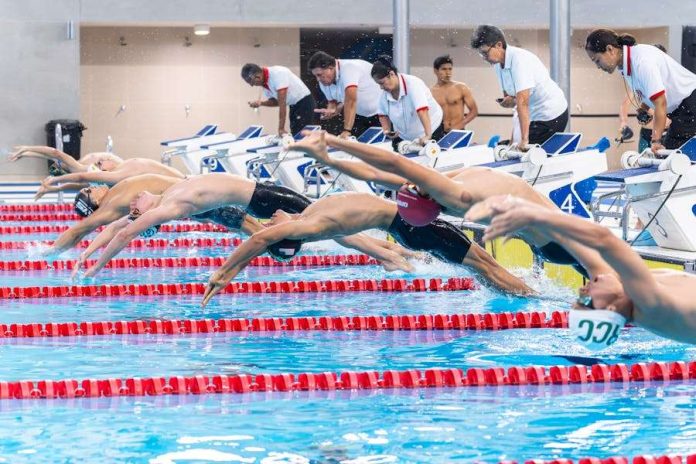Synchronized swimming, often referred to as “artistic swimming,” is a captivating blend of athleticism, artistry, and precision. While it may appear graceful and effortless from the sidelines, the reality is that synchronized swimming is an incredibly demanding sport. In this article, we’ll explore just how hard synchronized swimming is, breaking down the physical, mental, and technical challenges that make it one of the most rigorous disciplines in the world of sports.
What Is Synchronized Swimming?
Synchronized swimming is a hybrid sport that combines elements of swimming, gymnastics, and dance. Performers, either solo or in teams, execute intricate routines in the water, synchronized to music. These routines require athletes to maintain perfect timing, precise movements, and flawless coordination with their teammates—all while holding their breath and performing acrobatic feats underwater.
The sport has been part of the Olympic Games since 1984 and continues to captivate audiences with its unique blend of athleticism and artistry. But behind the glittering costumes and mesmerizing performances lies a world of intense training, discipline, and physical exertion.
The Physical Demands of Synchronized Swimming
1. Strength and Endurance
Synchronized swimmers are among the fittest athletes in the world. The sport requires a unique combination of strength, flexibility, and cardiovascular endurance. Swimmers must be able to support their body weight above water while performing complex movements, often using only their legs.
- Core Strength: A strong core is essential for maintaining balance and stability during lifts, spins, and other acrobatic maneuvers.
- Leg Power: Swimmers rely heavily on their legs to propel themselves out of the water and maintain precise movements.
- Cardiovascular Fitness: Routines can last several minutes, requiring athletes to have exceptional lung capacity and stamina.
2. Flexibility and Control
Synchronized swimmers must possess extraordinary flexibility to execute the high kicks, splits, and contortion-like movements that are hallmarks of the sport. Achieving this level of flexibility requires years of dedicated stretching and conditioning.
- Joint Mobility: Swimmers need flexible joints to perform movements like the “eggbeater” kick, which allows them to tread water while keeping their upper body stable.
- Muscle Control: Precision is key in synchronized swimming. Athletes must have complete control over their muscles to execute movements with perfect timing and alignment.
3. Breath Control
One of the most challenging aspects of synchronized swimming is the need to hold your breath for extended periods. Swimmers often perform intricate routines underwater, sometimes for up to a minute at a time.
- Lung Capacity: Training often includes exercises to increase lung capacity and improve breath-holding ability.
- Mental Discipline: Staying calm and focused while holding your breath is crucial, especially during high-pressure competitions.
The Mental Challenges of Synchronized Swimming
1. Team Coordination
Synchronized swimming is a team sport, and success depends on the ability of all team members to move in perfect harmony. This requires not only physical skill but also strong communication and trust.
- Timing: Every movement must be perfectly synchronized with the music and the other swimmers.
- Trust: Swimmers often perform lifts and throws, requiring complete trust in their teammates.
2. Memorization
Routines in synchronized swimming are highly choreographed and can last several minutes. Swimmers must memorize every movement, transition, and timing cue, often while performing in a high-pressure environment.
- Mental Focus: Athletes must stay focused and avoid distractions, even when performing in front of large audiences.
- Adaptability: Swimmers must be able to adjust their routines on the fly if something goes wrong.
3. Performance Under Pressure
Competitions can be incredibly stressful, with athletes judged on every aspect of their performance. The pressure to perform flawlessly can take a toll on even the most experienced swimmers.
- Confidence: Swimmers must believe in their abilities and trust their training.
- Resilience: The ability to bounce back from mistakes and stay composed is essential.
The Technical Skills Required
1. Precision and Timing
Every movement in synchronized swimming must be executed with pinpoint accuracy. Swimmers spend countless hours practicing their routines to ensure that every kick, spin, and lift is perfectly timed.
- Attention to Detail: Even the smallest mistake can disrupt the entire routine.
- Muscle Memory: Repetition is key to developing the muscle memory needed to perform movements automatically.
2. Choreography and Artistry
Synchronized swimming is as much an art form as it is a sport. Swimmers must convey emotion and tell a story through their movements, all while maintaining technical precision.
- Creativity: Routines are often designed to be visually stunning and emotionally engaging.
- Expression: Swimmers must use their facial expressions and body language to connect with the audience and judges.
3. Water Awareness
Being comfortable in the water is a given, but synchronized swimmers must also have an acute awareness of their position and movements in the water.
- Spatial Awareness: Swimmers must know where they are in relation to their teammates and the pool at all times.
- Buoyancy Control: Mastering buoyancy is essential for executing movements both above and below the water’s surface.
Training Regimen of a Synchronized Swimmer
To excel in synchronized swimming, athletes must commit to a rigorous training regimen that includes:
- Swimming Practice: Hours spent in the pool perfecting strokes, kicks, and routines.
- Strength Training: Weightlifting and resistance exercises to build muscle and endurance.
- Flexibility Training: Daily stretching and yoga to improve range of motion.
- Dance and Gymnastics: Cross-training to enhance coordination, balance, and artistry.
- Breath-Holding Exercises: Techniques to increase lung capacity and breath control.
Common Misconceptions About Synchronized Swimming
Despite its challenges, synchronized swimming is often underestimated. Here are some common misconceptions:
- It’s Not a Real Sport: Synchronized swimming requires incredible athleticism and should be recognized as a legitimate sport.
- It’s Easy Because It’s in Water: The water provides resistance, making movements more challenging than they appear.
- It’s Just for Women: While the sport is predominantly female, men are increasingly participating and excelling in synchronized swimming.
Conclusion: How Hard Is Synchronized Swimming?
Synchronized swimming is a sport that demands the perfect balance of physical strength, mental focus, and artistic expression. From the grueling training sessions to the pressure of competition, it’s clear that synchronized swimming is anything but easy.
For those who dedicate themselves to the sport, the rewards are immense—not only in terms of athletic achievement but also in the sense of camaraderie and personal growth that comes from being part of a synchronized swimming team.
So, the next time you watch a synchronized swimming performance, take a moment to appreciate the incredible skill, discipline, and hard work that goes into every movement. It’s a sport that truly deserves its place among the most challenging and awe-inspiring athletic disciplines in the world.


